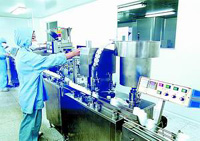 China's pharmaceutical industry is moving to sharpen its competitive edge as more effort and money are put into the development of new patented drugs.
China's pharmaceutical industry is moving to sharpen its competitive edge as more effort and money are put into the development of new patented drugs.
The Ministry of Science and Technology has just launched a dozen research and development projects in the hope of making significant technological breakthroughs and setting up new industries in three to five years.
Developing new drugs and modernizing the production of traditional Chinese medicines are among the ambitious programs.
China's pharmaceutical industry is already big, but solely in terms of the number of enterprises. It remains weak in the research and development of new products because it has long depended on copying imported drugs, according to industry analysts.
More than 6,700 drug companies produce about 1,300 types of synthetic medicines in China, 97 percent of which, however, are copies.
China's commitment to greater protection of intellectual property rights with its entry into the World Trade Organization makes the situation much harder for the domestic pharmaceutical industry.
As long as the domestic companies can provide few new drugs, they have to sit there and watch international pharmaceutical giants flocking in for bigger slices of China's market of medicines and health products, which is growing into one of the largest in the world.
The average growth rate of drugs sales in China has reportedly reached 20 percent in recent years, as the country has the world's biggest population and is rapidly turning into an ageing society.
Hopes of saving the industry previously were pinned on the country's thousand-year-old traditional medicine. But this has proved impossible unless modern technologies are used in the whole process, from laboratory experiment to production.
The ministry's project will help integrate human and facility resources at national labs, research centers and institutes for selection, safety evaluation, and clinical trials of new drugs.
The ministry hopes to see a group of compound synthetic medicines, herbal medicines, bio-engineered drugs, new vaccines and medicines for genetic therapies born as a result of the project.
But the ministry also indicated that the project was just a driving force for technological innovation. Participation of the industry is sorely needed.
Pharmaceutical companies will be encouraged to invest more in their R&D departments.
At present, Chinese companies put only two percent of their sales income into development, compared with more than 20 percent from leading pharmaceutical companies in the world.
(Xinhua News Agency August 2, 2002)
|

